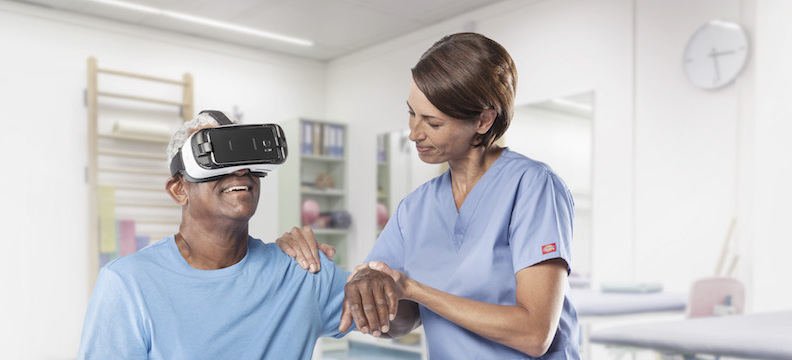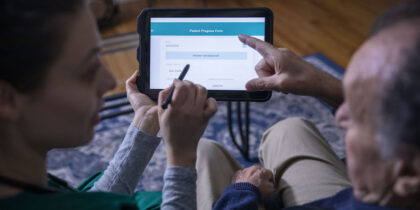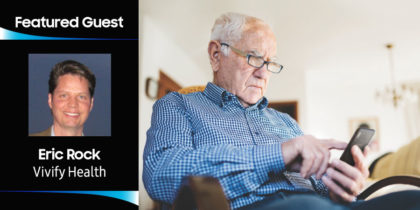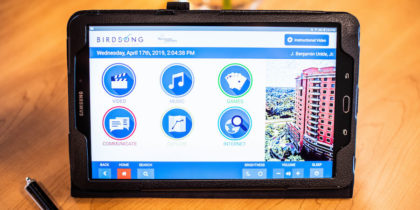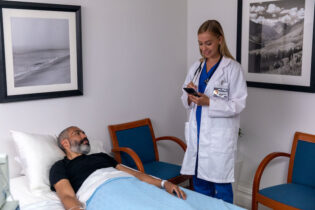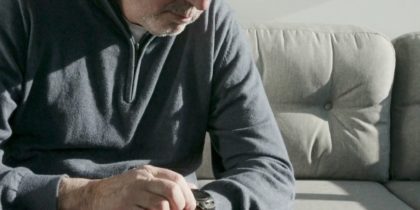Getting older isn’t what it used to be. Thanks to advances in medical technology and research, people are living longer, healthier lives. And thanks to advances in mobile technology for seniors, it’s easier for many of them to live safely and comfortably wherever they want to be, whether at home, with family or in a senior care facility.
These developments couldn’t have come at a better time. With baby boomers now reaching senior citizen status en masse, the “silver tsunami” that experts have been predicting is upon us. The number of Americans age 65 or older grew from 35 million in 2000 to 49.2 million in 2016, according to the U.S. Census Bureau. By 2030, seniors will comprise more than 20 percent of the population.
Not only do seniors have unique challenges that technology could help to solve — they also have significant buying power. Americans over age 50 are responsible for at least $7.1 trillion in annual economic activity, according to the AARP, which predicts that number will top $13.5 trillion by 2032.
To better meet the needs of this key demographic, technology companies, senior care experts and even governments are putting their minds and money together to create innovative solutions. Take, for example, the new Thrive Innovation Center. Built in Louisville, Kentucky, a major hub for the senior care industry, the Thrive Center received substantial grants and assistance from the state of Kentucky, the city of Louisville and a host of major technology companies. Now it provides a space for entrepreneurs and device manufacturers to collaborate and showcase their latest and greatest solutions.
Because the best technology for seniors is both cost-effective and easy to use, many of these solutions are built for or on consumer-grade smartphones, tablets and wearables. As a featured partner at the Thrive Innovation Center, Samsung showcases several cutting-edge solutions built on mobile devices, such as senior-friendly tablet software and vision-enhancing VR solutions.
How can mobile solutions like these improve the lives of seniors?
1. Vision Enhancements
Most seniors want to live as independently as possible for as long as possible, but vision impairments can make that difficult. New virtual reality (VR) technology can give back some of that independence by providing seniors a clearer view of the world around them.
Two of these visual aids, IrisVision and Relumino, integrate vision-enhancement software into Samsung Gear VR headsets with Samsung Galaxy smartphones. The software can be customized for specific low-vision conditions, such as macular degeneration, cataracts and severe myopia. Then, images from the smartphone camera are recreated to be viewed more easily based on the user’s unique vision problems.
2. Hearing Enhancements
It’s hard to connect with other people when you can’t hear them, so seniors often get left out of the conversation. Thankfully, hearing aids have come a long way in recent years. They’re more discreet and can better filter out background noise.
Create a Successful VR Pain Management Program
Download your roadmap to planning, executing and measuring the impact of your VR pain management program. Download Now
New Phonak hearing aids are even Bluetooth-enabled and sync up with smart devices such as internet-connected TVs and smartphones. With the Phonak mobile app, users can turn their hearing aids into wireless speakers. So, whether they’re talking to their grandchildren or their doctors, they’ll never miss an important word.
3. Caregiver Monitoring
Everyone slows down with age, mentally and physically. So how do adult children know when Mom isn’t getting around so well on her own? How can senior care facilities determine which residents are a greater fall risk or need closer observation? Those patterns are easier to spot with hard data, and digital sensors are key to gathering that data.
For example, Reemo Health has turned Samsung Gear smartwatches into remote monitoring devices. Using the watch’s sensors, Reemo tracks the wearer’s quality of movement, heart rate, sleep patterns and other relevant health data. Caregivers see daily data, a 30-day baseline for the individual and a three-day trend from that baseline. This way, they can spot negative trends and intervene quickly.
While Reemo tracks signs of physical decline, IoT-based Connected Home solutions can provide insights into cognitive decline. For instance, with the Samsung Smart Home app, users can monitor and control smart appliances. If Mom leaves the stove on or the refrigerator door open, her adult child gets an alert from the app. Sensors installed on doors and kitchen cabinets can also provide useful behavioral data. If Mom was opening her cabinets five times a day and now opens them 50 times a day, she might be experiencing memory loss. And if an assisted living community resident with dementia opens his door in the middle of the night, someone knows to go check on him.
4. Infotainment and Communication
Mobile technology provides many new ways to improve the lives of seniors, but that all hinges on seniors adopting the technology. Just like with any other demographic, it’s easier to get people to adopt technology when it’s fun to use. Mobile devices can offer seniors opportunities to learn, connect with family members and stream beloved television shows they haven’t seen in decades. But there’s also a technology learning curve that can be intimidating.
That’s why Breezie has created senior-friendly tablets. Using Samsung Knox, Breezie configures the settings and apps on Samsung Galaxy tablets to simplify the user experience. Breezie technicians and approved family members can access the device remotely to provide training and tech support.
Breezie is also offering a new platform for senior care facilities. Built on Samsung Knox and Artik frameworks, the platform enables care providers to deliver personalized services, medical information and disease management education to residents through a simple tablet interface.
These solutions are just the tip of the iceberg. As innovative companies and thinkers put their heads together to solve age-related challenges, much of the best technology for seniors is yet to come.
Learn more about how healthcare technology solutions can enhance efficiencies and improve the patient experience.
